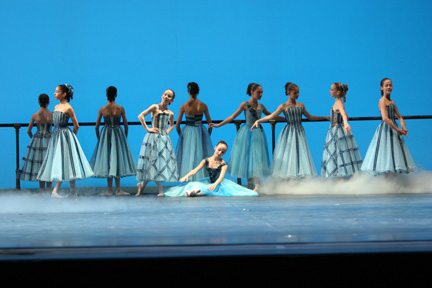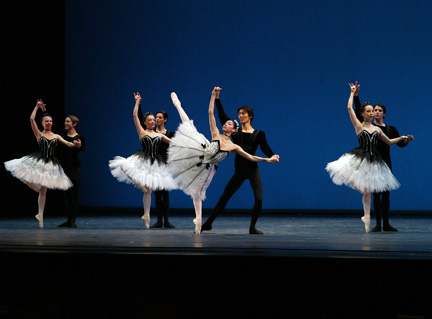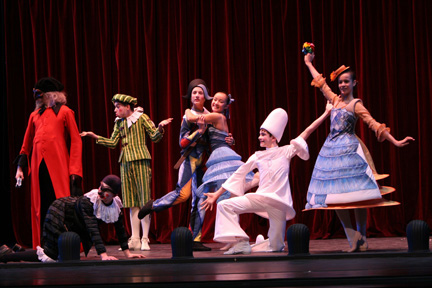No Moment Wasted
Protégés: The International Ballet Academy Festival
Atrium and Opera House
The John F. Kennedy Center for the Performing Arts
Washington, DC, USA
January 25 & 26, 2006
by George Jackson
copyright ©2006 by George Jackson
 Youth isn't always wasted on the young! 104 students from six of the world's important academies for classical ballet were invited to Kennedy Center this past week to perform, take class together and talk. Talk came first. Ten pupils from five of the schools—the Paris Opera's, the Royal Danish Ballet's, Britain's Royal Ballet's, Dance Theater of Harlem's and that of Japan's New National Theater—met the public in the rooftop Atrium room on the evening of January 25 for a question and answer session about their training and themselves. These were advanced students, one female and one male from each of the institutions except Japan's which was represented by two young women. The group's members had much in common besides youth. All understood and spoke at least a little English although the Japanese and French sometimes relied on the help of translators. The young women were dressed up more than "the guys" (the only two male students wearing suits and ties were from Japan and sat in the audience). Julia Ward, interlocutor, first asked the panelists to identify themselves by name, age and school, and then tell us how they spent a typical day.
Youth isn't always wasted on the young! 104 students from six of the world's important academies for classical ballet were invited to Kennedy Center this past week to perform, take class together and talk. Talk came first. Ten pupils from five of the schools—the Paris Opera's, the Royal Danish Ballet's, Britain's Royal Ballet's, Dance Theater of Harlem's and that of Japan's New National Theater—met the public in the rooftop Atrium room on the evening of January 25 for a question and answer session about their training and themselves. These were advanced students, one female and one male from each of the institutions except Japan's which was represented by two young women. The group's members had much in common besides youth. All understood and spoke at least a little English although the Japanese and French sometimes relied on the help of translators. The young women were dressed up more than "the guys" (the only two male students wearing suits and ties were from Japan and sat in the audience). Julia Ward, interlocutor, first asked the panelists to identify themselves by name, age and school, and then tell us how they spent a typical day.
Lots of dance classes consume the students' time, ballet predominating. There are the general technique session as well as partnering and, for the older girls and young women, pointe lessons. Other dance and theater forms (character, mime or acting) are also taught and in Japan much emphasis is placed on indigenous forms such as Kabuki. Timing for academic courses varies—some schools schedule these classes in the morning and others in the afternoon—but dance and academics together add up to long days, particularly when the students are also expected to attend company performances as participants or audience, or rehearse for and give school performances. No one has time for outside activities and friendships except the Harlem pupils, some of whom have to hold outside jobs.
Outreach proved to be variable and student teaching became quite controversial. The American and British students seemed to be the most involved in giving lecture-demonstrations to young audiences. Elisabeth Platel, ballerina emerita and now principal of the Paris Opera's ballet school, spoke up from the audience against the idea of student teachers and even training programs to develop teachers. Her conviction is that only good, experienced dancers can teach.
How had ballet come into these lives? That varied individually. In some cases the precipitating cause had been a parent, a chance encounter or a minor study assignment turning major. At some point in time, though, ballet had become a passion, an obsession for each and everyone!
What choreographers did the students admire? They translated this question into "What is your dream role?". Across the board, male and female, the answer was the lead in "Swan Lake". This response was perhaps, a chain reaction. Next in line for Parisians were the other "classics", for Harlem it was Balanchine ballets, for the Royal it was works by MacMillan and Cranko (not Ashton!), whereas the Japanese mentioned their teacher Mme. Maki Asami's choreographies while the Danes opted for Forsythe and Neumeier (not Bournonville!). No one at this Protégés festival, though, got to dance "Swan Lake". How did the students think they differed from the preceding generation? They wanted to be even better and thought of themselves as already being more globalized, more influenced by ballet and dance from around the world.
 First on the first program were pupils of the Royal Ballet with Frederick Ashton's "Birthday Offering". Watching this work ought to be like opening an enticing gift box. Elegantly wrapped in ensemble dancing are seven imaginatively varied, meticulously crafted solos for the ladies of the cast. Each solo is as nuanced, faceted and absolutely finished as an item from Faberge's workshop. The crowning jewel is a regally serene adagio for the first ballerina and her consort. The cast's men present their solo selves simultaneously: in other words, although they dance as a coherent group, it ought to be possible to also see each as an individual. Glazounov's music, unashamedly lilting and lush, prompted Ashton to add just a touch of preciosity to this ballet's perfection. How did the pupils fare in choreography and styling intended for the top echelon of one of the world's great ballet companies? On January 26—splendidly! There was pleasure in the waltzing of the pairs as they took to the stage of the Opera House, a firm yet gentle force propelled the men's joint forward leap, precision and personality showed in the women's solos and, most admirably, everyone knew who in the world and where in the world they were supposed to be. Only the handclasp partnering for pinpointe balances seemed to present difficulties.
First on the first program were pupils of the Royal Ballet with Frederick Ashton's "Birthday Offering". Watching this work ought to be like opening an enticing gift box. Elegantly wrapped in ensemble dancing are seven imaginatively varied, meticulously crafted solos for the ladies of the cast. Each solo is as nuanced, faceted and absolutely finished as an item from Faberge's workshop. The crowning jewel is a regally serene adagio for the first ballerina and her consort. The cast's men present their solo selves simultaneously: in other words, although they dance as a coherent group, it ought to be possible to also see each as an individual. Glazounov's music, unashamedly lilting and lush, prompted Ashton to add just a touch of preciosity to this ballet's perfection. How did the pupils fare in choreography and styling intended for the top echelon of one of the world's great ballet companies? On January 26—splendidly! There was pleasure in the waltzing of the pairs as they took to the stage of the Opera House, a firm yet gentle force propelled the men's joint forward leap, precision and personality showed in the women's solos and, most admirably, everyone knew who in the world and where in the world they were supposed to be. Only the handclasp partnering for pinpointe balances seemed to present difficulties.
It was daring of the Harlem pupils, whose school had shut down for financial reasons and only recently re-opened, to tackle the strict counts and sharp contours of George Balanchine's Bach ballet, "Concerto Barocco". As the stage curtain flew up on 10 women of distinctly diverse appearance, it was difficult to see them as a ballet corps. When they began to move, differences of impetus became apparent. What showed too, though, was willpower and in this there was unanimity. The group was going ahead and as the women's drive to dance meshed with the relentless logic of Bach and Balanchine (first movement only), a clearer picture of this school came into focus. It is for an athletic classicism that Harlem seems to be striving.
 Paris presented Jose Martinez's "Scaramouche" as the first of two pieces. Wit but not brevity characterize this pantomimic divertissement performed principally by the school's younger pupils. Also, it seemed to me, that Martinez sometimes confounded stage infrastructure with theatrical substance. However, this artifact to music by Milhaud and others has hilarious moments, some touching ones too and made its didactic points plainly. The most important lesson illustrated is that young pupils should never be forced to perform beyond their appropriate stage of development. The girls danced on half pointe and the boys, although energetic, attempted no tours de force. Martinez believes that dance education should recapitulate dance history, and so his images proceeded from commedia dell'arte through romanticism and the high classical to our era of pop. He managed this while keeping the acting and dancing simple, and ended on the tonic: the children starting a basic ballet class at the barre. Even called on to mug, these Parisian kids did so with control. They got a big hand from the audience!
Paris presented Jose Martinez's "Scaramouche" as the first of two pieces. Wit but not brevity characterize this pantomimic divertissement performed principally by the school's younger pupils. Also, it seemed to me, that Martinez sometimes confounded stage infrastructure with theatrical substance. However, this artifact to music by Milhaud and others has hilarious moments, some touching ones too and made its didactic points plainly. The most important lesson illustrated is that young pupils should never be forced to perform beyond their appropriate stage of development. The girls danced on half pointe and the boys, although energetic, attempted no tours de force. Martinez believes that dance education should recapitulate dance history, and so his images proceeded from commedia dell'arte through romanticism and the high classical to our era of pop. He managed this while keeping the acting and dancing simple, and ended on the tonic: the children starting a basic ballet class at the barre. Even called on to mug, these Parisian kids did so with control. They got a big hand from the audience!
"Peches de Jeunesse", for Paris's advanced students, is Jean-Guillaume Bart's exploration and exploitation of complex partnering and also of the small, rapid steps for which French ballet training used to be known. To the choreographer's credit is his refined use of technique and the understated elegance of his lyrical impulses. At times, though, the step combinations become too dry an accompaniment for music by Rossini that is rather juicy. The touches of young love Bart introduces feel like afterthoughts and aren't really needed as excuses for the technical experimentation that's his purpose and passion. Paris' young women danced with superb self-composure and its young men partnered with dispatch.
The young ballet artists being taught at the New National Theater in Tokyo were not only remarkably uniform in deportment and training but also thoroughly trained. Their phrasing, to my taste, could be more varied and their manner might gain from being a little playful. They performed Mme. Asami's "Sinfonietta", a neat but inventively uneven ballet in the plotless, neoclassical mold. The music is by Charles Gounod, a score Balanchine used in 1958 for his "Gounod Symphony". The choreography has a fine feeling for continuity and a sense of humor for such things as codas but, when rushed, tends to repeat the same step too often.
The Royal Danes danced bits of Bournonville (the opening of the "Flower Festival in Genzano" pas de deux and extracts from the pas de six in the last act of "Napoli"). It is said that one should always leave a fine repast wanting more. I wanted more Bournonville, lots more, but choreography wasn't the point of this occasion. Training was. The staging by Anne Marie Vessel Schluter, assisted by Niels Balle, demonstrated how different body types are being taught to dance the perky, buoyant combinations of Copenhagen's master choreographer. This showed particularly with two of the young men, Sebastian Kloborg and Alban Lendorf-Thim. The latter, being short and broad, has an "old time" body that looks naturally good in the open chested, frontal moves and stances Bournonville often used. For stretch, though, both in motion and in balance, people of this anatomic sort usually have to work hard. Kloborg is the taller, slimmer, streamlined type on whom Bournonville's fast, intricate "French" step vocabulary could look trivial. Work corrects this too. Both dancers, Kloborg and Lendorf-Thim, mastered movement that wasn't natural for them, and did so with aplomb.
,%20pas%20de%20deux%20from%20The%20Nutcracker%20by%20Carol%20Pratt.jpg) There were just two dancers from the sixth academy, Russia's Vaganova School in St. Petersburg. Daria Vasnetsova and Vladimir Shklyarov are recent graduates, now full time with the Kirov/Maryinsky Ballet and so represented the culmination of training. She is elongate, delicate and thoughtful. At moments she resembled the late Tanaquil LeClercq. He is full bodied, handsome, direct. In the pas de deux version of the grand adagio from Vainonen's "The Nutcracker", her dancing at its best was spun lace and his was velvet cushions.
There were just two dancers from the sixth academy, Russia's Vaganova School in St. Petersburg. Daria Vasnetsova and Vladimir Shklyarov are recent graduates, now full time with the Kirov/Maryinsky Ballet and so represented the culmination of training. She is elongate, delicate and thoughtful. At moments she resembled the late Tanaquil LeClercq. He is full bodied, handsome, direct. In the pas de deux version of the grand adagio from Vainonen's "The Nutcracker", her dancing at its best was spun lace and his was velvet cushions.
Consistency varies with all dancers, but students, especially, must learn how to pace themselves. This opening night was definitely an "up" occasion from beginning to end. What about globalization? For better or worse, legs everywhere in the ballet world extend higher than before. However, Protégés proved that historic differences still show at the student level—the Royal's graciousness and straight spines, Paris's elegant placement and arched feet, Japan's precision, Harlem's ambition, the spaciousness and pliancy of the Vaganova/Maryinsky, and the Danes' magic that makes viewers itch to dance. May differences persist! Are all of them taught? How important are the things left out of lessons? The great Alexandra Danilova used to say that she instructed her students in what she knew and believed, but how they danced reflected those lessons only in part.
Photos, all by Carol Pratt:
First: Paris Opera Ballet in a scene from Jose Martinez's "Scaramuche."
Second: Royal Ballet School in "Birthday Offering."
Third: "Scaramouche."
Fourth: Daria Vasnetsova in "The Nutcracker."
Volume 4, No. 4
January 30, 2006
copyright
©2006 George Jackson
www.danceviewtimes.com
|
|